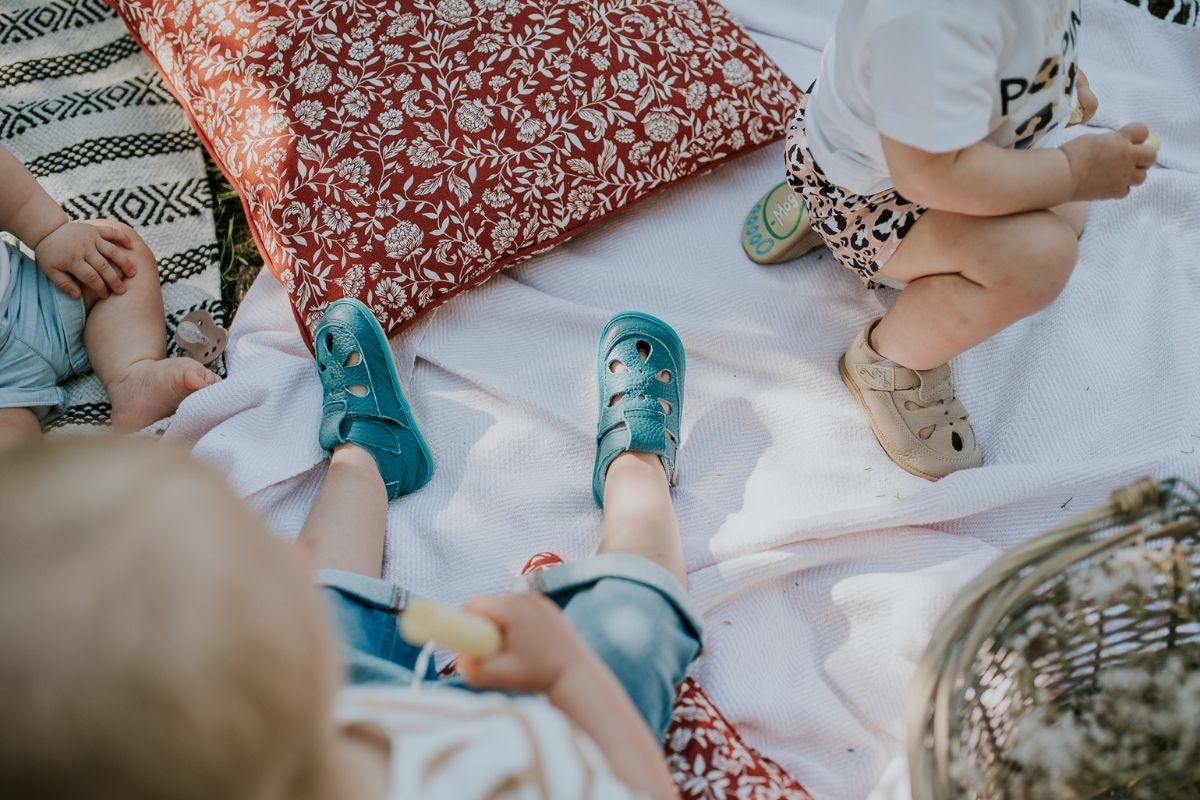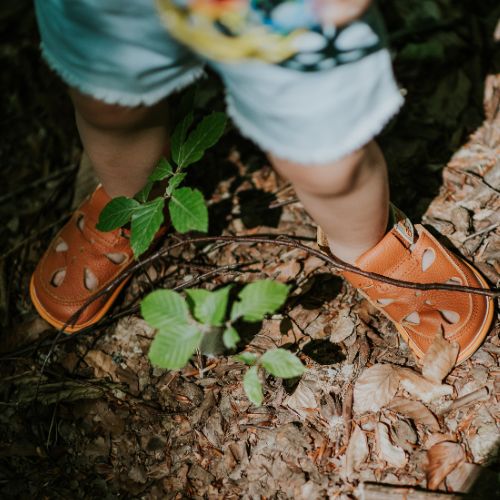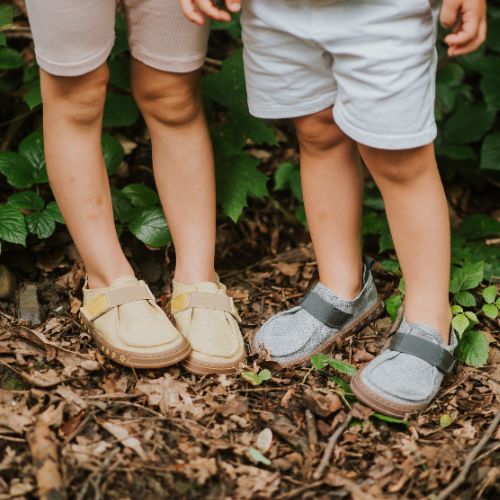- Women's
- Men's
- Kids
- Accessories
- Sale
- Blog
- Discover more
- Sign in / Register











Healthy children's feet – why is it important to take care of children's foot health?
The proper psychophysical development of a child, especially in the first years of life, largely depends on diverse experiences. Achieving developmental milestones is based on the curiosity about the world and the desire to explore it. The inner need for movement and the encoded movement patterns drive the whole body of a young person to develop. Healthy children's feet are largely the result of their spontaneous activity and the environment they have been in. Taking care of their proper development facilitates the future acquisition of increasingly complex motor skills, such as running, playing football, ballet, or acrobatics. The first years of development of children's feet form the foundation on which a young person will be able to rely throughout their life.
How does a child's foot develop – proper foot development in the first year of life?
Even as an infant, a child exercises their feet and prepares them for the role they will play during walking. The first training begins in the mother's womb when the baby practices kicking, strengthening their legs and learning to feel the boundaries of their body. At birth, the heel of the newborn is tilted outward, and the foot is in eversion (pronation), and it needs to practice a lot to gradually align itself closer to the adult position. Initially, the baby can make primitive kicks without fully extending the hip. During the first six months of life, the baby also has a grasp reflex in their feet – if we touch the soles under the toes, they will spread their toes and then grab the object with their toes. This reflex gradually disappears as the child starts to stand up.
Around the third month, the baby's foot begins to position itself in an intermediate position. Similarly, the pelvis aligns, and external rotation appears in the hip joints. By three months, the baby starts touching their knees with their hands and later rubs their feet together, learning the boundaries of their body. Around the sixth month, a very important moment in foot development occurs: supination, or the turning of the foot. This is the time when the baby grabs their feet and tries to put them in their mouth, and through this activity, they begin to shape the foot arches, which will support healthy and functional feet in the future.
From around the eighth month, very dynamic development can occur: children make rapid progress, transitioning from a lying baby to an exploring toddler within weeks. This is called the developmental triad, where the child quickly learns to sit, crawl, and stand. This period also marks rapid foot development: the child experiences many new positions in which the foot should move freely. It is crucial not to restrict the child's range of motion during this time and, if possible, allow them to explore the world barefoot or in shoes that closely imitate barefoot walking.
Walking sideways along furniture is an extremely important element of development: it’s excellent foot gymnastics for children, alternating pressure on the outer and inner edges of the foot, preparing the muscles for walking. It's important to let the child experience this stage and not rush it by encouraging them to walk independently or holding their hand.
The way a child develops in their first year of life allows for predicting potential foot problems in the future. Typically, foot deformities may result from genetic factors or arise from developmental challenges in the first years of life.
Preschooler – issues with children's feet
For young children who are already walking freely, an important aspect of prevention is properly fitted children’s footwear. When buying shoes, it is crucial to ensure they are the right size. The first step is to measure the child’s foot length. It is best to measure the foot while the child is standing, as this is when we can truly assess its length. Ask the child to stand on a piece of paper, and mark the longest toe and the back of the heel. It is also important to measure the width of the foot, as shoes must not be too narrow. Since small feet grow quickly, it is worth monitoring them, ideally every two months, as the child’s foot can grow in that time. It’s important to be vigilant, as some children won’t tell you if their shoes are getting too tight. This is a major issue because if a child wears too-tight shoes for too long, it can cause permanent foot deformities. On the other hand, choosing shoes that are too narrow in the toe area can lead to ingrown toenails due to continuous pressure from the shoe on the nail.
Foot care for children and the proper shoe size play a significant role in preventing foot problems and ensuring proper foot development. It is also essential to properly trim the nails, especially the big toe. Children can get ingrown toenails not only from rubbing against too-tight shoes but also if we cut their nails too short or too much at the edges.
What shoes for preschool?
It is important to note that a child, during free play, does not stay only in a standing position. They usually squat a lot, sit, kneel, sit on their heels, crawl, climb... These are all natural exercises for the feet, and our task is to enable the child to perform them. When buying shoes for children with proper development, we should look for models that allow the foot to move freely in all directions – for this reason, so-called orthopedic or preventive shoes, which have a rigid heel counter, immobilized ankle, and a fixed sole, will hinder the proper development of the foot. Studies show that wearing such shoes does not prevent flat-footedness, also known as flat feet.


Golden age of motor skills – development of older children
During the school years, between 9 and 12 years of age, the so-called golden age of motor skills occurs. This means that the child has mastered all the movements of an adult and enters a period of refining them. Parents should respond to the child's need for movement by offering various physical activities. Some children attend martial arts classes, others prefer dance or team games, and some enjoy free play outside – the important thing is that the activity is enjoyable for the child. As all the bones of the body grow longer, there is also growth in children's feet during this period – often, muscles lag behind the suddenly growing bones. At this time, some feet may appear flat again or start to "turn in" towards the center. Unfortunately, children's feet are exposed to increased loads during puberty – which is why it is even more important to strengthen them. The basic form of training is free foot movement during various activities – just like in minimalist Magical Shoes, where the foot works as if it were barefoot. In some cases, when the child's feet require therapy, it should focus on strengthening the strength, endurance, and neural control. Sometimes, orthopedic insoles are applied too early, instead of giving the foot muscles a chance to "catch up" with bone growth. Sometimes, traditional correctional methods may be ineffective because children perform outdated exercises that do not target the intended effect of correcting foot alignment.
Foot deformities in children – what position is normal?
The issue with children's feet is that they don't look or function the same way as an adult's foot. Children have a fat pad, which can make their feet appear flat. Additionally, from around the ages of 3 to 7, the foot goes through a phase of physiological valgus. This means that it is natural for the foot and knees to move slightly inward. This is a necessary movement for the proper formation of the growth cartilage! Therefore, the use of orthopedic insoles or preventive orthopedic shoes in healthy children is not recommended. However, there are no exact standards for the physiology of flat-footedness in children, so if parents have any doubts, it is best to consult with a physiotherapist who can assess the functional development of the child's feet. In such an assessment, the therapist does not focus only on the appearance of the feet but also evaluates the higher levels: the knees, hips, pelvis, and spine. The therapist analyzes the body in static positions, but most importantly, evaluates the child in dynamic movement, i.e., during free activity.
The impact of children's foot alignment on the whole body
Children's foot problems are often a symptom of underlying difficulties in the body. For example, increased joint mobility (hypermobility) often manifests as excessively flat or valgus feet. However, on the other hand, incorrect foot positioning can lead to postural issues. For example, when the right foot is excessively pronated (inward), it causes the knee to rotate inward (valgus knee, in the "X" position), which leads to a dropping of the pelvis on that side, and from there, it’s just a step away from the development of scoliosis. The foot, therefore, can be both a symptom of other issues and a cause of their development. If anything concerns a parent, it is advisable to consult a specialist: a pediatric orthopedist or physiotherapist. The sooner we address an emerging problem, the better the child will develop.
Literature:
B. Zukunft-Huber, Three-Dimensional Manual Therapy of Foot Deformities in Children, 3rd ed., Edra Urban &Partner, 2020, p. 3-27.
Kanatli U., Aktas E., Yetkin H. Do corrective shoes improve the development of the medial longitudinal arch in children with flexible flat feet? Journal of Orthopaedic Science, 2016, 21(5), p. 662-666.
Ueki Y., Sakuma E., Wada I. Pathology and management of flexible flat foot in children, Journal of Orthopaedic Science, 2019, 24(1), p. 9-13.
See children's footwear
Healthy shoes that support the healthy development of the foot.








































